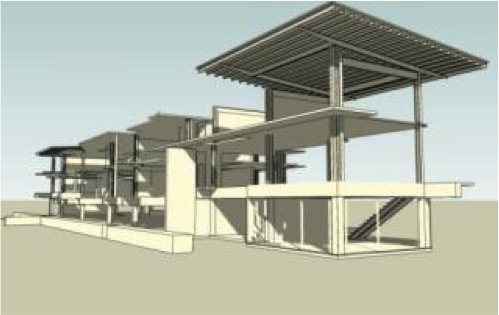Stalled project ‘never would have gotten done’ without Archicad BIM software
BOSTON, June 22, 2011 – What’s greener than a new LEED Gold, NetZero building packed with EnergyStar appliances?
Renovation.
 |
| Pease Place |
That’s the philosophy of Kit Johnson, the Austin, Texas, architect who’s beautifying the city’s notorious “eyesore of Enfield Road.” The 25-unit condo project, stalled since 2007 because of financial and legal issues, until recently was graffiti-ridden and vandalized. Thanks to Johnson’s hard work, it’s now roaring to completion as Pease Place.
“We love energy efficiency,” Johnson says, “but the biggest impact is in renovation over new construction when it’s feasible.” Johnson credits Graphisoft’s Archicad building information modeling (BIM) software for making Pease Place feasible.
“The original plans wouldn’t have sold and shouldn’t have been built,” Johnson said. “There were some neat ideas – ideas that would be great fun to contemplate in an architecture class – but they made no sense in the real world. In order to build it, we’ve had to make hundreds of changes to the original design to accommodate the realities of the site and its existing bones. This never would have gotten done without Archicad.”
 |
| Original Structure |
Johnson’s firm, architecture365, inherited the job when it was half built. It had functional problems like open vertical shafts that collected water and bred mosquitoes. It had esthetic problems like exterior walkways that robbed views and privacy from the condos. The consensus: tear the existing structure down to its concrete foundation and steel frame.
Stucco and stone are replacing corrugated metal siding. Wood floors and recycled quartz countertops are replacing the industrial interiors of the original design.
architecture365 modeled a new design on the old structure in Archicad, starting with data imported from 2D CAD and surveying software. The original construction documents, however, did not match reality, so Johnson’s team had to constantly verify the design in the Archicad BIM model.
“These changes were quite manageable in Archicad yet would have been extraordinarily time-consuming and expensive in ‘flat CAD’,” he said. “Plus, we were incorporating the normal changes a client will make, such as moving a window or door. We executed these modifications in probably a quarter of the time it would have taken in two-dimensional CAD. With BIM, you’re automatically adjusting plans, sections and elevations all at once. And some of the stunts we pulled with Archicad would have crashed competing BIM software based on my experience. Bottom line, without Archicad, I wouldn’t have any way of doing what I’m doing.”
An added benefit of Archicad was the ease of sharing data with partners, such as the mechanical, electrical and plumbing (MEP) consultant. After Johnson sent her an Archicad model, Tessa Roberts, project manager for EN Inc. of Austin, wrote back, “Whatever you did, that is what we need to do from now on…. Thank you, thank you and thank you.” By packing data into every design element and deftly handling late changes, Archicad has even changed the way architecture365 estimates design fees, according to Johnson. A lot less time is allocated to construction drawings.
“Best of all, I’m actually finding the challenge of projects like Pease Place to be a total joy,” he says. “And it’s truly green.”